Related Research Articles

Albert I of Habsburg was a Duke of Austria and Styria from 1282 and King of Germany from 1298 until his assassination. He was the eldest son of King Rudolf I of Germany and his first wife Gertrude of Hohenberg. Sometimes referred to as 'Albert the One-eyed' because of a battle injury that left him with a hollow eye socket and a permanent snarl.

Albert the Magnanimous KG, elected King of the Romans as Albert II was king of the Holy Roman Empire and a member of the House of Habsburg. By inheritance he became Albert V, Duke of Austria. Through his wife he also became King of Hungary, Croatia, Bohemia, and inherited a claim to the Duchy of Luxembourg.

Year 1298 (MCCXCVIII) was a common year starting on Wednesday of the Julian calendar.
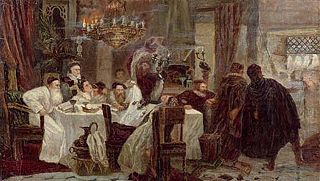
Marranos is one of the terms used in relation to Spanish and Portuguese Jews who converted or were forced by the Spanish and Portuguese crowns to convert to Christianity during the fifteenth and sixteenth centuries, but continued to practice Judaism in secrecy or were suspected of it, referred to as Crypto-Jews. "Crypto-Jew" is the term increasingly preferred in scholarly works, instead of Marrano.
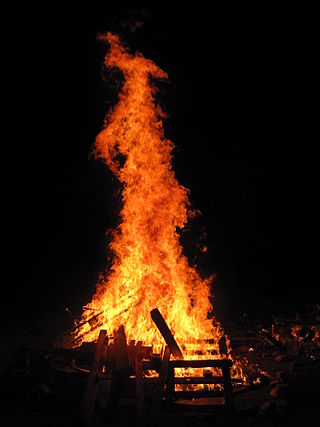
Iyar is the eighth month of the civil year and the second month of the Jewish religious year on the Hebrew calendar. The name is Babylonian in origin. It is a month of 29 days. Iyar usually falls in April–May on the Gregorian calendar.
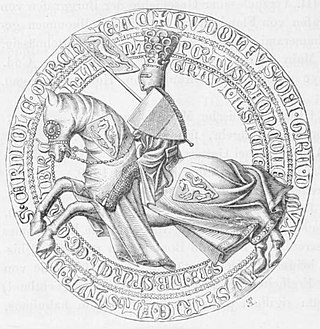
Rudolf I, also known as Rudolf of Habsburg, was a member of the House of Habsburg, the King of Bohemia and titular King of Poland from 1306 until his death. He was also Duke of Austria and Styria from 1298.

The Rhineland massacres, also known as the German Crusade of 1096 or Gzerot Tatnó, were a series of mass murders of Jews perpetrated by mobs of French and German Christians of the People's Crusade in the year 1096, or 4856 according to the Hebrew calendar. These massacres are often seen as the first in a sequence of antisemitic events in Europe which culminated in the Holocaust.

The House of Hohenlohe is a German princely dynasty. It formerly ruled an immediate territory within the Holy Roman Empire, which was divided between several branches. In 1806, the area of Hohenlohe was 1,760 km² and its estimated population was 108,000. The motto of the house is Ex flammis orior. The Lords of Hohenlohe were elevated to the rank of Imperial Counts in 1450, and from 1744, the territory and its rulers were princely. In 1825, the German Confederation recognized the right of all members of the house to be styled as Serene Highness, with the title of Fürst for the heads of its branches, and the title of prince/princess for the other members. From 1861, the Hohenlohe-Öhringen branch was also of ducal status as dukes of Ujest.

Casimirof Brandenburg-Bayreuth was Margrave of Bayreuth or Margrave of Brandenburg-Kulmbach from 1515 to 1527.

Röttingen is a town in the district of Würzburg, in Bavaria, Germany. It is situated 30 kilometres (19 mi) south of Würzburg, and 15 kilometres (9 mi) east of Bad Mergentheim.
This timeline of antisemitism chronicles events in the history of antisemitism, hostile actions or discrimination against Jews as members of a religious and/or ethnic group. It includes events in Jewish history and the history of antisemitic thought, actions which were undertaken in order to counter antisemitism or alleviate its effects, and events that affected the prevalence of antisemitism in later years. The history of antisemitism can be traced from ancient times to the present day.

The Duchy of Styria was a duchy located in modern-day southern Austria and northern Slovenia. It was a part of the Holy Roman Empire until its dissolution in 1806 and a Cisleithanian crown land of Austria-Hungary until its dissolution in 1918.

The history of the Jews in Alsace is one of the oldest in Europe. It was first attested to in 1165 by Benjamin of Tudela, who wrote about a "large number of learned men" in "Astransbourg"; and it is assumed that it dates back to around the year 1000. Although Jewish life in Alsace was often disrupted by outbreaks of pogroms, at least during the Middle Ages, and reined in by harsh restrictions on business and movement, it has had a continuous existence ever since it was first recorded. At its peak, in 1870, the Jewish community of Alsace numbered 35,000 people.
Martyrdom in Judaism is one of the main examples of Jews doing a kiddush Hashem, a Hebrew term which means "sanctification of [the] name". An example of this is public self-sacrifice in accordance with Jewish practice and identity, with the possibility of being killed for no other reason than being Jewish. There are specific conditions in Jewish law that deal with the details of self-sacrifice, be it willing or unwilling.

The persecution of Jews during the Black Death consisted of a series of violent mass attacks and massacres. Jewish communities were often blamed for outbreaks of the Black Death in Europe. From 1348-1351, acts of violence were committed in Toulon, Barcelona, Erfurt, Basel, Frankfurt, Strasbourg and elsewhere. The persecutions led to a large migration of Jews to Jagiellonian Poland and the Grand Duchy of Lithuania. There are very few Jewish sources on Jewish massacres during the Plague.
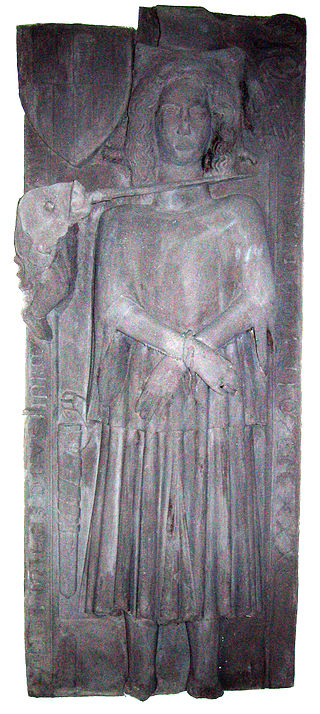
Arnold III von Uissigheim, also blessed Arnold und "König Armleder", (c.1298–1336) was a medieval German highwayman, bandit, and renegade knight of the Uissigheim family, of the village Uissigheim of the same name. He was the leader of the "Armleder" massacres against Jewish communities throughout the Alsace in 1336.

The Lisbon massacre started on Sunday, 19 April 1506 in Lisbon when a crowd of churchgoers attacked and killed several people in the congregation whom they suspected were Jews. The violence escalated into a city-wide, anti-semitic riot that killed as many as 4,000 "new Christians" (cristãos-novos), the name for Jews who had been forcibly converted to Christianity.
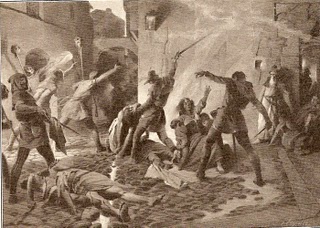
The Massacre of 1391, also known as the pogroms of 1391, was a display of antisemitism and violence against Jews in Castile and Aragon. It was one of the Middle Ages' worst antisemitic outbreaks. Jews in the Iberian Peninsula at this time were generally disliked, and violence against them was common even until the 15th century. The year 1391, however, marked a peak of anti-Jewish violence. Facing death, many Jews converted en masse to Christianity from 1391 on.
The Armleder persecutions were a series of massacres against Jews in Franconia and Alsace in 1336–1339.
References
- ↑ Miri Rubin Gentile Tales: The Narrative Assault on Late Medieval Jews 2004 p48 "This is nowhere more evident than in the events which led to the months-long regional wave of violence which has come to be known as the Rintfleisch movement (Rintfleischbewegung)"
- ↑ Les annales et la chronique des Dominicains de Colmar: p178 Charles Gérard, Joseph Liblin - 1854 "Veniens in Franckoniam carnifex Rindtfleisch, id est caro bovis , « nomine, qui Judeos cepit et interfecit et eorum res diripuit violenter, « nec erat impedire. » Ante Assumptionem beate Virginis venit in Argentina Albertus rex ..."
- ↑ Christ among the medieval Dominicans Kent Emery, Joseph Peter Wawrykow - 1998 "Rintfleisch, the popular leader of the massacres, is designated by Rudolph as " the butcher" (camifex). It is unclear whether Rintfleisch was a real name, an occupational tag, or a punning name based on his reputation."
- ↑ Haim Beinart (1981), Carta's Atlas of the Jewish people in the Middle Ages; Carta Jerusalem; ISBN 965-220-035-2